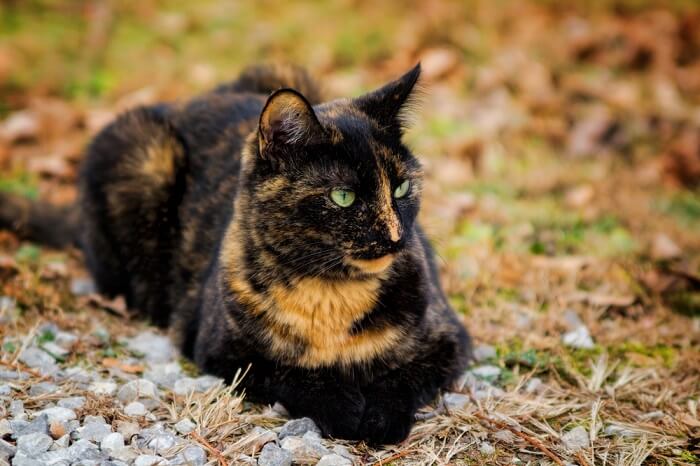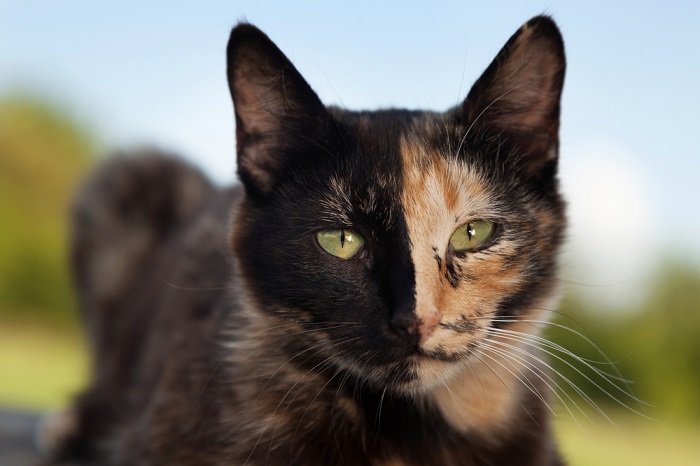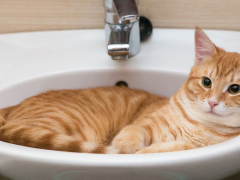
Tortoiseshell (tortie) and calico cats are both common coat colors and patterns that appear almost always in females. The names tortoiseshell and calico are often confused, and it is easy to understand why.
Both of these patterns apply to a multi-colored cat that might consist of brown and orange, black and orange, grey and cream with relatively little to no white markings. While a tortoiseshell coat might not have any white at all, a calico coat always contains white.
These coat color patterns can occur in random-bred as well as purebred cats with either long or short coats.
In this article, we will explain the differences and similarities between the tortoiseshell and calico cat.
What Are Tortoiseshell Cats?

Tortoiseshell cats are almost all female. In the rare event that a tortoiseshell cat is a male, he is usually sterile.
Tortoiseshell is not the name of a breed, but a description of a color pattern that can appear in cats of many different breeds and mixes. By definition, a tortoiseshell cat is a feline with a coat that resembles the mottled or particolored shell of a tortoise. Tortoiseshell cats are almost exclusively female. In the rare event that a tortoiseshell cat is a male, he is usually sterile.
Tortoiseshell coats show up in many different purebred domestic cats, as well as in non-purebred cats. Traditional tortoiseshell cats are a blend of deep orange and black colors. “Dilute” tortoiseshell cats are a lighter gray and orange rather than black and orange. Because torties are not a specific breed of cat, their overall coloring usually appears brindle.
A chimera coat describes a tortoiseshell cat that is one color on one side of its body and a different color on the other side. This can occur on the face or throughout the entire body. In either case, their coat may be a healthy mix of dark black or chocolate, with shades of ginger, red or orange color mixed in.
A tortoiseshell cat has a reputation of having a distinct, strong personality and feisty attitude, a phenomenon commonly referred to as “tortitude.”
What Are Calico Cats?

The calico cat coat can come in a wide variety of coat patterns, and no two are alike.
Calico is not the name of the breed but a description of a color pattern that appears in many different cats. Mainly female, a calico cat is fairly easy to recognize because of its orange, black and white patterned coat. The calico cat coat can come in a wide variety of coat patterns; like fingerprints, no two are alike.
Traditional calico cats have large piebald type white, orange and black patches. “Diluted” calicos have gray rather than black in their coat coloring. Calico cats can also be called tortie-and-white, tricolor, torbie or piebald cats.
Differences Between Tortoiseshell and Calico Cats

The main difference between tortoiseshell and calico cats is the existence of white in the coat. Tortoiseshell cats only have two types of colors, black and orange (or gray and orange in the dilute version), with no white.
A calico cat has an extra gene present for piebalding, which results in white or unpigmented areas on the body of the cat. This may show up as a white-colored cat with few colored patches or an entirely colored cat with few white patches on his coat. A calico always has three colors: white, black and orange (or white, grey and orange in the dilute version).
Similarities Between Tortoiseshell and Calico Cats

Tortoiseshell and calico cats have some notable similarities, one being that almost all of them are female. The black and orange color pattern seen in tortoiseshell cats and the tri-color pattern seen in calico cats is delivered via the X chromosome. Two of these X chromosomes are needed to produce either of these specific coats, which is why most tortoiseshell and calico cats are females.
In addition, tabby markings are frequently found in both tortoiseshell and calico cats coats. The tortoiseshell or calico tabby cat is basically a tri-colored cat with traditional tabby cat stripes, and may contain spots of red or orange fur.
Both tortie cats and calico cats are known for being extremely independent and frisky. Calicos are usually considered a little more friendly while tortoiseshells are known for their no-nonsense attitudes.
Tortoiseshells and calicos have similar lifespans of around 15 years, on average, and are both beloved and common house cats to keep either inside or outdoors.
How They Get Their Pattern

Almost all tortoiseshell and calico cats are females and have two X chromosomes—one for orange (XO), one for black (XB).
As mentioned, almost all tortoiseshell and calico cats are females. They have two X chromosomes, one for orange (XO), one for black (XB). They only pass one of those on to the next generation.
Males, however, have one Y chromosome and one X chromosome, which is either orange (XO) or black (XB). When and if a male tortoiseshell or calico cat is born, it’s because he inherited an extra X chromosome, XXO or XXB, which is very rare. These male cats are known to have health issues, like aortic valve diseases and frail bones.
Here is more of an explanation about how it works:
- Female XO + Male XO = orange
- Female XO + Male XB = mixed orange+black pattern
- Female XB + Male XO = mixed orange+black pattern
- Female XB + Male XB = black
In addition to these chromosomes, the XX female code is the most usual. However, the male should have an extra Y chromosome (XXY) to have a tortoiseshell or calico color pattern. The black and orange cat pigment gene is attached to the X chromosome. This is how an orange tabby kitten with tort and calico coloring appears.
Cat Breeds
One thing to understand about both the tortoiseshell and calico cat is that neither is technically considered a breed of cat. The tortoiseshell and calico cat description is used to categorize the coat color and pattern of each.
Some cat breeds do contain these patterns in their breed standards, like the Maine Coon or Japanese Bobtail, which can display the calico coloration. Both the tortoiseshell and calico coat patterns have become somewhat noteworthy, and some people use the names to refer to the type of cat rather than the specific breed.
Here are some breeds with tortoiseshell or calico markings:
Tortoiseshell

Calico

Because calico cats are not a breed unto themselves, calicoes will have unique and varied personalities influenced by a wide range of factors.
- American Shorthair
- Arabian Mau
- British Shorthair
- Exotic Shorthair
- Japanese Bobtail
- Manx
- Norwegian Forest Cat
- Persian
- Siberian
- Turkish Angora
- Turkish Van
Are Tortoiseshell and Calico Cats Rare?

Yes, and these color patterns are even rarer in the context of males which only occur in one in every 3,000.
Females may be seen more often in different breeds. Both the orange color and black cat pigment genes must be present to result in a tortoiseshell or calico cat coat.
Final Thoughts

Tortoiseshell cats are orange-and-black cats resembling the body patterning of a tortoise, while calico cats have three colors in their coat (orange, black, and white). The terms tortoiseshell and calico are mainly used to signify the color patterns of the cat’s fur and are not considered a breed.
Tortoiseshell and calico cats are usually females, while male cats are very rare and usually sterile. In either instance, these cats are considered to be good luck for their respective owners.
Frequently Asked Questions
Is tortoiseshell the same as calico?
No, the two names refer to two coat colors. Calicos have a three-color coat combination in white, black and red-orange. Tortoiseshells lack the white and have a black-and-orange mottled coat.
Can tortie cats have white on them?
No. Traditional tortoiseshell cats are primarily black, red and orange with brown mixed in. There are also dilute tortoiseshell cats with less intense coloring due to genetics and even chocolate tortoiseshell cats with much darker fur.








This is very helpful info for me as I’ve been feeding the stray cats that live in my area & doing what I can to socialize some. I’m also using humane traps to take them to get fixed & vaxxed when I can. There were 3 kittens in a litter that were quite a bit older when I started socializing them & I call them the ‘letter litter’ because I named them B for boy, G for girl & M for Multicolored. G is now friendly with me but M is barely but still very jumpy. Well I didn’t get them in time to get fixed and they both ended up having their kittens in my tiny place. M in a carrier I had on top of my fridge. After a couple weeks she moved them outside someplace but surprisingly recently brought them back in. G had hers on my bed then moved them under my bed. They both had 5 kittens each. M has 2 that are orange, 2 that are mostly gray & black & 1 tortoise shell now that I know the difference! G had 5 tortoise shell. And another younger cat I call Splash had 5 kittens in my cat tree outside. She’s black & white and has 4 B&W kitties & 1 tortoise shell. Sorry so long but I find it all amazing, including how the mom’s talk to their babies. M’s were both the 24th of April so they should be old enough to all get fixed as well as mom. As soon as the others are old enough they’re going too! Hopefully all the babies will be adopted out to good people. And thanks so much to Metro Denver Cats for all their help. And thanks for letting me share this. I’m sure nobody will read this or all of it but I wanted to share with someone! Yes I’m that crazy cat lady everyone makes fun of and who cares! Want a kitten?
Thank you!!!! For all you do for the kitties in yr little part of the world!!! I know it’s not easy but I’m SO very grateful for people like you willing & able to do it!! Ys, genetics is fascinating, especially in cats!! Kudos to you for wanting to learn more about it & I thoroughly enjoyed reading about yr cats & their story!!! (Yes, I would LOVE ANY cat!!
That’s heart warming story. Thank you for saving all these cats. Dont if your story was long, to me it was a beautiful story. I have two cats, a tortie and a tuxedo cat.
From one crazy cat mom to another, I enjoyed reading about your cats. Kudos to you, and Metro Denver Cats, for caring for the feral cat community. If there were more people like you, there wouldn’t any strays at all. God bless you and keep up the good work.
hi, I’ve commented on the previous article, about calico cats. how lucky i am, i just found an adult male calico cat. but the cat came to my house in a state of injury. his leg was seriously injured, sore with pus. I smeared the wound with olive oil. I don’t have the budget to go to the vet. I hope this magical cat gets well soon.
Sorry, my English is bad. I’m from Indonesia
Hello! My apologies for the late reply. Assuming that you’re unable to obtain a veterinary antibiotic, you may also want to wash his wound gently with soap and water—the pus is indicative of infection, and you’ll want to clear that out and protect it with gauze and tape. I wish you all the best!
I have a male Maine Coon and went to retrieve him one evening from outsideand found a small stray tortie lyiin the driveway with him. She started to run off and I coaxed her back. She was pregnant despite being not much more than a kitten herself. She was barely showing. I started feeding her. She would show up every night to eat and disappear during the day. She had her kittens in the woods behind our house. Eventually she adopted me and before I could have her spayed she became pregnant again. She comes home every evening and stays in the garage. I think she will have her kittens there this time. She is small and very vocal and will let only me hold her. She wants nothing to do with any other human. I find it funny that as small as she is she runs my Maine Coon off. He’s so much bigger than she is and he is so scared of her. lol.
Actually ,Torties can have a tiny bit of white and still be considered Torties. “Tortoiseshell” is typically reserved for multicolored cats with relatively small or no white markings. So Torties can have tiny bits of white and still be considered(and are still considered “Torties”.
Thanks for the info, Steph!